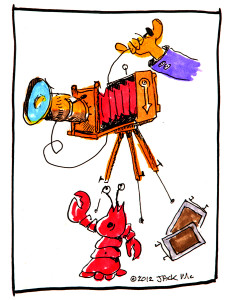Share & show your photography
Every time I open my Facebook pages, I’m so happy to see Islesboro friends sharing their photography. Linda Mahan snaps the inevitable duck, chicken, or flower from her backyard garden. Diana Roberts posts her daily drama through the Inland Waterway on her way to the Caribbean, and the tribulations of her house renovation on the island. Sharon Hall shares sunrises and sunsets. Rhonda Shand documents the joys of Ava. And Laura Toran breaks my heart with her gorgeous island details.
Now that digital cameras have made life easier for the photographer, the possibilities of taking a pretty decent photograph and making a wonderful print are highly likely. With easy access to the internet, even a remote Maine islander can improve his photography by reading professional photographer blogs with tons of useful tips, and by thumbing through reviews and discussions of the photographer-greats. What a wonderful thing to have a life in photography. And I encourage everyone who enjoys photography as a leisure sport to take their hobby seriously.
Listen Up!
You know what? You don’t take enough photographs. The best way to learn and get better is by shooting more. “Get the picture” then bang off some crazy frames for yourself. Often there will be a better picture than the obvious one. It doesn’t matter whether your friends like it or not. Do it for yourself. To learn. To see in a new way. You should do this EVERY time you take your camera out. Don’t miss an opportunity to stretch your imagination. Yes, you’ll throw a lot of shots away. But you’ll learn something every time. Use your filters, play with light, use another lens, blur the image, angle the camera, get too close…you know the routine. Do it! Shoot without looking through your viewfinder. Double or triple-expose. It’s all just a game, an experiment. Study what you’ve done. Learn from it. Have fun.
Start creating collections
In the back of your mind should be a favorite personal project you can go to on a slow day. Something you can shoot for yourself to get away from your usual demands. It should be easy to get to, so you can pick it up at any time. Don’t work aimlessly. Have a goal to achieve, a project that’s cohesive, yet simple. For ten years I photographed the streets of Hartford—architectural details, but also people I met as I walked along. Now I only bring my 600mm lens when I go out, giving me amazing close-up details of the city. If I stretch out my arm, my lens captures the image area under my thumb! That’s all!
Right now, I’m shooting New England stone walls and CT farmers. I go out whenever I have a couple of hours to spare, head off in a new direction, or return to a scene in different weather or at a different time of day or season of the year. It gives me an excuse to go places I haven’t been before.
In the summer, when I vacation on Islesboro, I keep returning to Cliff’s auto junkyard to capture new images of the “rusted and busted”, cars, trucks, buses, and industrial parts splayed out among the weeds. It’s a discipline to find something new in the familiar, and a joy, because you always do!
For about five years on Labor Day weekend, I would sleep overnight on the fairgrounds at Lancaster, New Hampshire and get up at dawn to shoot the rumpled men who run the amusement park rides and the cranky concessionaires who haven’t yet had their cup of coffee. In the studio, I shoot “everyday objects”, that favorite cooking utensil you associate with your grandmother, or a tool that hung in your dad’s workshop. Almost all these special projects become a body of work that I share and show in local galleries or public spaces. I’ve always got a couple of collections in the works, so I don’t even have to think about what to shoot when I have a few extra hours to spare. Check out my website to see the kinds of work that make a collection: www.stonewalljack.com
So, how about exhibiting some of your work?
Finding wall space isn’t that easy. You’ll rarely sell anything hanging in a restaurant, bank, or library. But you’ll get a little recognition, and it can be a place to start. When I first came to Islesboro back in ‘82, I hung in the Islesboro Inn and among the clattering diners at Shake’s Blue Heron. Then almost every summer in Charlotte’s Arts & Crafts show at Historical, and finally a show of my own. Paula ran the Seven Knots Gallery for three summers where I could really spread out and share my work. And now we all have the Art of the Isles at the Community Center to enjoy looking at art year-round.
Last week I hung 31 photographs in a gallery show titled Sit Down. The photos were taken over a 35-year period in Lisbon, Paris, Boca Grande, FL, outside a West Hartford coffee shop, in the horsepulling ring at a Lancaster, NH country fair, on the beach at an island wedding in Maine. You get the picture. A little of this, from a lot of theres.
It’s very rewarding to curate a show from your own work and present a proposal to a gallery. So try to shoot in Collections where you can, and periodically review your entire body of work to see what works together to make a show.
Start to keep a mailing list of everyone you can think of who might one day buy your work, especially friends moving into new homes or offices who have a few bare walls to fill. Try to find out who recommends art to hospitals, law firms and medical centers. Sometimes it’s the interior designer, or the space planner or relocation specialist at a corporation, or the interiors department in a big architectural firm. Keep those names in a preferred mailing list and tease them with information regularly. Develop a website just for your art photography, and post new work and email potential buyers with a link or send them a piece of direct mail. And create some bodies of work, or collections, so that when the call comes you’re ready to do a show. Put an art bio together, and an artist statement explaining what each collection is all about. Enter photo competitions and group shows whenever possible and keep track of your credentials. Check out the Art Calendar section of your local newspaper and the various statewide art magazines and get yourself off the couch and out for a night of art. Check out the summer art festivals and decide if you have the energy to show your work in these outdoor venues. Being a seasoned professional, your work should stand out from the crowd, and you’ll learn a lot about the process of making a retail sale.
Join the ASMP Fine Art Specialty Group and read emails about some of the national photo shows and how to approach national galleries. Check out the possibilities of selling your work on the internet, and peruse gallery websites that specialize in photography and see what you can learn. If you’ve got a significant project underway, start looking at getting a grant or applying for an artist-in-residence sabbatical. Find yourself some like-minded friends and form a little support group to share the work and keep the energy flowing. Take yourself seriously and feed this side of your photography life. Your assignment work will likely pay the bills and give you fame and glory. But showing and sharing your personal vision is a gift that never stops giving. And if nothing else, support the work of other photographers—buy their books, purchase their prints, or swap for one of your own. And encourage their effort by sending a note or an email with your personal feedback. Not just the Attaboy! But specific comments, one photographer to another, about some aspect of their work. Trust me, there’s no one they’d rather hear from than you.
Note: Several samples from Jack’s new Islesboro Collection posters can be viewed and purchased at Jack’s website www.sevenknotsgallery.com and are for sale in the Art of the Isles Gallery at the Islesboro Community Center. Large hand-painted prints and B&W prints can be ordered on the Purchase page of the website, www.sevenknotsgallery.com.





